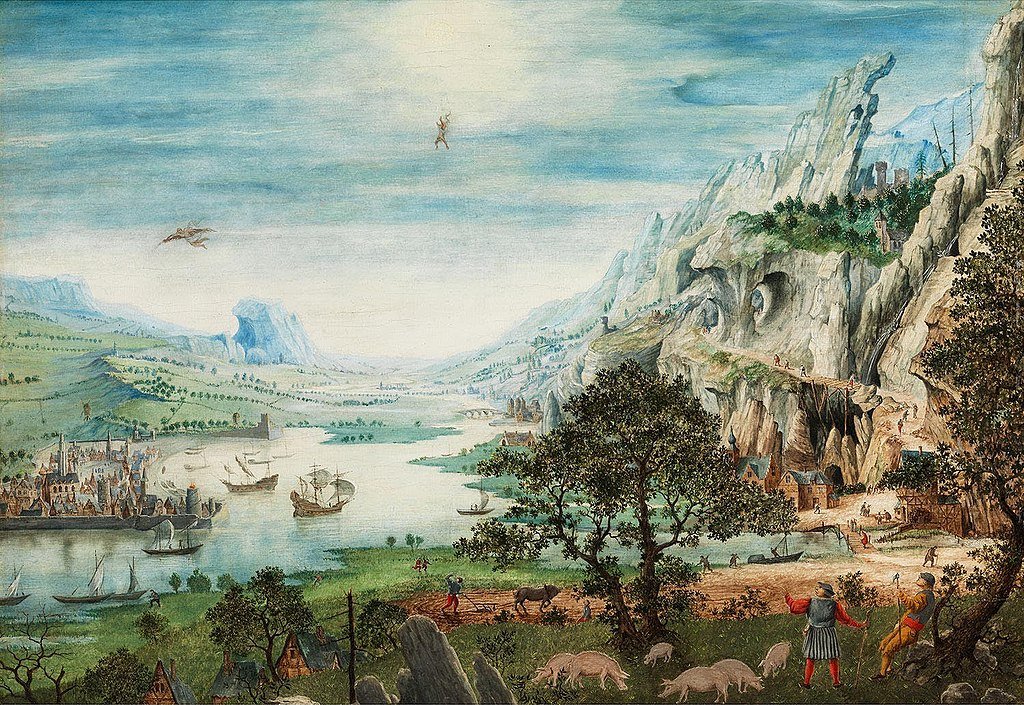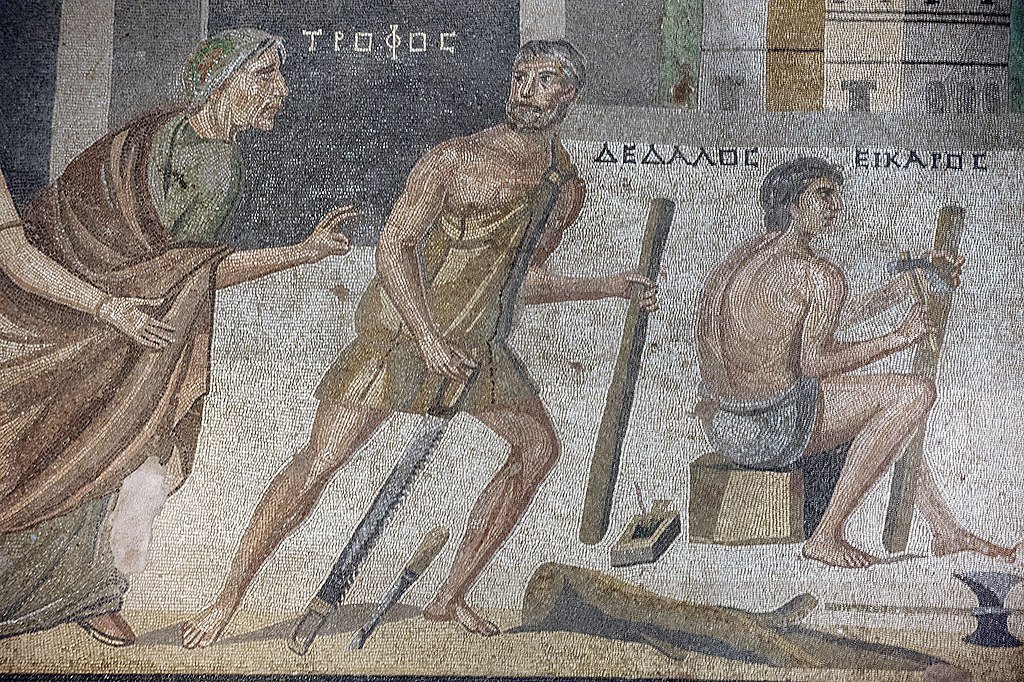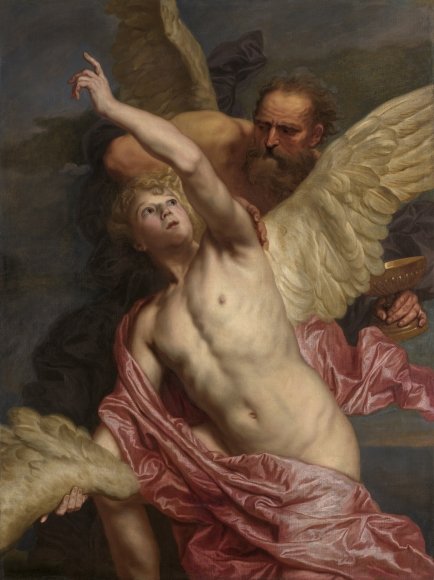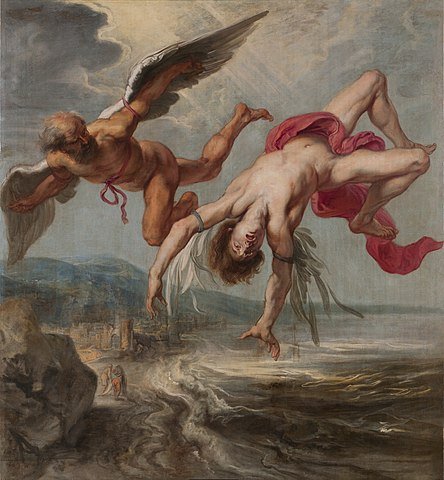The myth of Icarus and Daedalus is a captivating Greek tale, that blends history and mythology. Daedalus designed the Minoan Palace of Knossos in Crete, an extraordinary archaeological treasure in Greece. This magnificent palace boasts 1,300 rooms adorned with breathtaking frescoes and artifacts, still preserved today.

In 1903, the Wright brothers achieved a groundbreaking feat by inventing the first successful airplane, revolutionizing human transportation. The advent of flight marked a momentous milestone in history, fulfilling mankind’s age-old dream of soaring through the skies.
Long before this achievement, flying had captivated the human imagination for centuries. Ancient Indians spoke of Vimanas, while Leonardo da Vinci envisioned intricate flying machines inspired by birds. In Europe, myths and tales abounded about people taking flight, with the legend of Daedalus and Icarus being the most famous.
They attempted flight using wings made of wax and feathers, but Icarus flew too close to the sun despite his father’s warnings, leading to his tragic demise. This timeless tale serves as a cautionary reminder of the consequences of reckless ambition.
The Characters in The Story of Icarus and Daedalus
Daedalus: Daedalus, a highly skilled architect, and craftsman, was renowned for his wisdom, knowledge, and power. His intelligence was legendary, making him the finest artificer known far and wide. He is the father of Icarus, the uncle of Perdix, and possibly the father of Iapyx. Among his notable creations are the wooden cow for Pasiphaë, the Labyrinth that imprisoned the Minotaur for King Minos of Crete, and the wings he and his son Icarus used in their attempt to escape Crete in this tale.
Icarus: Icarus, the second primary character of the myth was the young son of Daedalus and Nafsicrate, a servant of King Minos. He found himself imprisoned by the king but was gifted wings by his father to help him escape.
King Minos: In Greek mythology, Minos, the son of Zeus and Europa, ruled as the King of Crete. He enforced a gruesome tribute of seven young boys and seven young girls to be sent to the labyrinth, built by Daedalus, to be eaten by the Minotaur every nine years. After his passing, Minos became a judge of the dead in the underworld.
Daedalus in Athens
In Ovid’s account (Metamorphoses VIII.236-259), Daedalus hailed from Athens, though some sources suggest he was Cretan. Renowned for his exceptional skill and intellect, Daedalus became a respected figure in his city. He had a young apprentice, his nephew Talus, who showed remarkable talent and surpassed even his uncle’s craftsmanship at a tender age. Together, they worked in Daedalus’s workshop in Athens, where the young Talus displayed promising signs of becoming a masterful craftsman in his own right.
The nephew exhibited remarkable ingenuity. One day, while strolling along the seashore, he discovered a fish spine. With a piece of iron, he notched the edge and invented the saw. Another time, he joined two pieces of iron, securing them with a rivet, and sharpened the ends, thus creating a pair of compasses. Daedalus took immense pride in his nephew’s achievements but also harbored jealousy of the young prodigy.
During a visit to the Acropolis, Daedalus pushed him off the edge, fearing a rival. Some versions suggest that the boy pushed off the Acropolis was not Talus but Perdix, his sister’s son and apprentice. To save Perdix from a fatal fall, the compassionate Goddess Athena transformed him into a bird, and he flew to safety. Daedalus faced trial before Areios Pagus, the supreme court of Athens, on charges of murder. As punishment, he was banished from Athens and sent to the island of Crete.
Daedalus in Crete
In the realm of Crete, King Minos ruled from his palace in Knossos. Daedalus, a skilled architect, found employment there and eventually fell in love with Naucrate, one of the king’s mistresses. They married and welcomed a son named Icarus.

Life continued peacefully until Minos approached Daedalus with a peculiar task – the construction of an enclosure for the Minotaur, a creature with the body of a man and the head and tail of a bull.
After ascending the throne of Crete, King Minos faced conflict with his brothers over the claim to power. Seeking divine approval, Minos prayed earnestly to Poseidon for a sign. In response to his devotion, Poseidon sent a magnificent snow-white bull as a symbol of kingship.
Overwhelmed with joy, Minos promised to sacrifice the bull in honor of the sea god. However, consumed by greed and ambition, he decided to keep the bull for himself, defying his vow. Infuriated by Minos’ betrayal, Poseidon sought revenge by cursing Minos’ wife, Pasiphae, to fall deeply in love with the bull, leading to the birth of the monstrous Minotaur.
Daedalus Builds the Labyrinth
Consumed by an unnatural desire for the bull, Pasiphae turned to Daedalus for help. He constructed a peculiar wooden cow for her, inside which she could approach the bull. Their strange union led to the birth of the Minotaur, a fearsome creature with the body of a man and the head of a bull. Filled with shame and horror at his wife’s actions, King Minos sought to conceal the monstrous offspring, which grew larger and more violent with each passing day.

To contain the Minotaur, Minos commissioned Daedalus to build a labyrinth—a maze with intricate twists and turns where one could easily get lost. The structure’s complexity was so great that even Daedalus himself struggled to find the way out. Ovid, in his work “Metamorphoses,” praised Daedalus’s ingenuity, stating that even the master craftsman barely managed to escape the labyrinth’s intricate design.
Hidden at the heart of the labyrinth, the Minotaur remained a dreadful secret, terrifying Minos’ enemies and subjects alike. To satisfy its monstrous appetite, the Minotaur had to be fed by young people, perpetuating the horror within the walls of the maze.
Daedalus and Icarus in Prison
According to Ovid, Daedalus developed a strong aversion to Crete and longed to return to his homeland. However, Minos was determined to retain the skilled inventor’s services and took measures to keep him near.
Other versions of the tale suggest that Minos imprisoned Daedalus in a cell after discovering his involvement in Pasiphae’s forbidden act, aiding Theseus’ escape, or merely safeguarding the secrets of the Labyrinth. Consequently, both Daedalus and his son Icarus were confined to a high tower by the King.
Daedalus Builds The Unbelievable
Locked in their prison atop the tower, Daedalus and Icarus planned their escape. The master craftsman realized that their only route to freedom was through the air, as King Minos controlled all vessels leaving the island and thoroughly searched every ship. Instead of succumbing to despair, Daedalus devised a brilliant plan. Studying the birds flying around the tower, he observed their behavior and found his solution. Gathering feathers and joining them with wax, he crafted two pairs of wings—one for himself and one for his son.

When the day of their escape arrived, Daedalus warned Icarus not to fly too close to the sun, for the heat would melt the wax, nor too close to the sea, for the moisture would make the feathers wet. With their wings flapping furiously, they took flight, emulating the birds, and swiftly put considerable distance between themselves and Crete as they soared over the sea. However, something unfortunate happened next.
The Fall of Icarus
Regrettably, Icarus disregarded his father’s warning and was lost in the thrill he felt while flying. He soared too close to the sun. The intense heat melted the wax on his wings, and the feathers came loose. Helpless, he fell into the sea and drowned. Daedalus was devastated, naming the sea-spot and an adjacent island after his lost son – the Icarian Sea and Ikaria.

As Icarus fell, Hercules happened to pass by and gave him a proper burial. Filled with remorse, Daedalus flew to Sicily, seeking refuge in King Cocalus’ Court. With the King’s aid, he built a temple to Apollo and retired his wings as an offering to the god.
King Minos Discovers Daedalus
In Crete, King Minos was furious and frustrated by Daedalus’ incredible escape. His sole focus was to capture the skilled craftsman and return him to Knossos. Minos was well aware that Daedalus would disguise himself to avoid detection, making the hunt a challenging task. He knew that the master artificer could never resist a perplexing riddle or task.
Determined, Minos embarked on a journey in search of Daedalus, offering a handsome reward to anyone who could thread a spiral sea shell. He understood that this was a highly intricate puzzle that would surely challenge Daedalus. Eventually, Minos arrived at Camicus and announced a reward for anyone who could solve the puzzle. Many attempted to solve it, but none succeeded.
Upon hearing the news, King Cocalus promptly summoned Daedalus, fully aware that if anyone could solve the puzzle, it would be him. Despite his old age, Daedalus’ brilliant mind remained sharp, and as he examined the sea-shell puzzle, he knew precisely what to do. Placing a drop of honey at one end of the shell, he tied a string to an ant and let the insect wander through the intricate spirals. Drawn by the sweet scent of honey, the ant emerged at the other end, successfully threading the shell.
Minos realized he had found his man and demanded that the clever Daedalus be handed over. However, Cocalus persuaded Minos to stay in Camicus to rest. Cocalus’s daughters, impressed by Daedalus’ stories, plotted against Minos. When it was time for Minos’ bath, they poured scalding water on him, exacting what could have been Daedalus’ revenge for the death of his son caused, in part, by Minos.
Daedalus Disappears
Daedalus left Camicus after his disguise was exposed, leaving behind the disappointed King and his daughters. He was last seen in Sardinia with Hercules’ nephew, Iolaus. The rest of his journey, inventions, and experiences remain shrouded in mystery.
Today, Daedalus symbolizes a brilliant individual cursed to suffer due to his unique talents, burdened by the guilt of his son’s death. His enigmatic story continues to captivate, representing the highs and lows of exceptional creativity.
Theme of The Story of Icarus and Daedalus
The myth of Daedalus and Icarus embodies the themes of technology, balance and pride. Daedalus, a brilliant inventor, built the labyrinth and crafted wings to escape. His success highlights man’s ingenuity and the potential of technology.
However, the story also serves as a warning about the dangers of unchecked technological advancements. Icarus, filled with pride, disregards his father’s caution and flies too close to the sun, leading to his tragic demise.
The actions of Icarus represent the perils of overestimating one’s abilities and underestimating the consequences of actions. The myth serves as a timeless reminder of the delicate balance between human intelligence and humility, urging caution in the pursuit of progress and the acknowledgment of our limitations.
Summary of The Story of Icarus and Daedalus
The myth of Daedalus and Icarus involves the skilled architect Daedalus, who designed the labyrinth to imprison the Minotaur. King Minos imprisoned Daedalus and his son Icarus to protect the secrets of the labyrinth. To escape, Daedalus created wings from branches and wax. He warned Icarus not to fly too close to the sun or else the wax would melt. Excited by the thrill of flight, Icarus ignored the warning, and his wings melted, causing him to fall into the sea and drown. The myth symbolizes man’s attempt to defy nature and the consequences of recklessness.
Also Read: The story of Eros and Psyche
